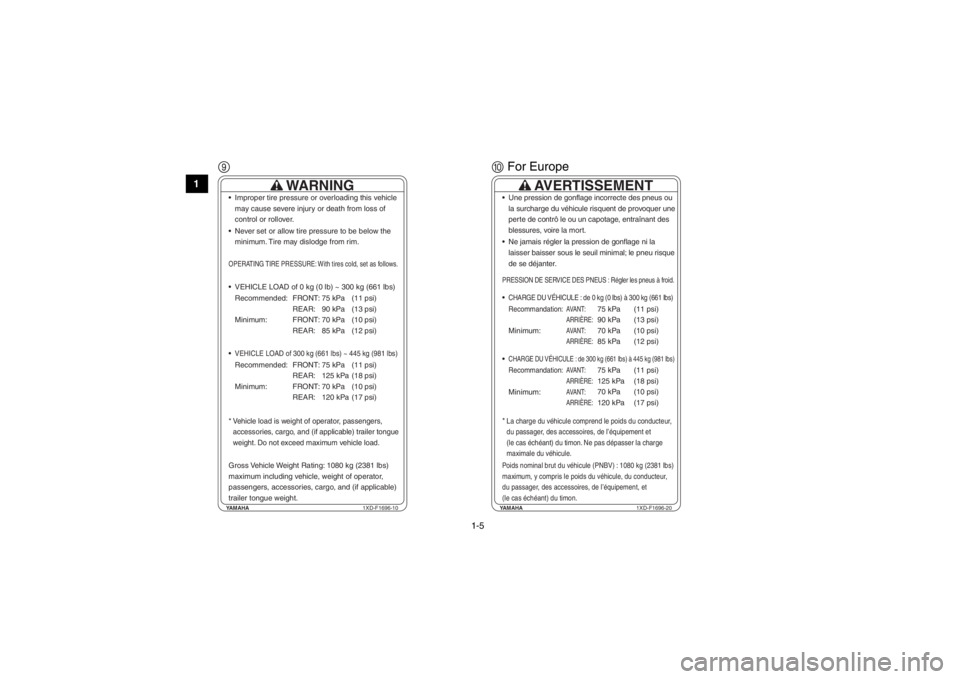Page 14 of 180

1-5
1
2
3
4
5
6
7
8
9
10
11
12
13
14
90 For EuropeYAMAHA 1XD-F1696-10
WARNING
Improper tire pressure or overloading this vehicle
may cause severe injury or death from loss of
control or rollover.
Never set or allow tire pressure to be below the minimum. Tire may dislodge from rim.
VEHICLE LOAD of 0 kg (0 lb) ~ 300 kg (661 lbs) Recommended: FRONT: REAR:
Minimum: FRONT: REAR:75 kPa
90 kPa
70 kPa
85 kPa
VEHICLE LOAD of 300 kg (661 lbs) ~ 445 kg (981 lbs)Recommended: FRONT: REAR:
Minimum: FRONT: REAR:75 kPa
125 kPa
70 kPa
120 kPa (11 psi)
(13 psi)
(10 psi)
(12 psi)
(11 psi)
(18 psi)
(10 psi)
(17 psi)
*Vehicle load is weight of operator, passengers,
accessories, cargo, and (if applicable) trailer tongue
weight. Do not exceed maximum vehicle load.Gross Vehicle Weight Rating: 1080 kg (2381 lbs)
maximum including vehicle, weight of operator,
passengers, accessories, cargo, and (if applicable)
trailer tongue weight.OPERATING TIRE PRESSURE: With tires cold, set as follows.
YAMAHA 1XD-F1696-20
AVERTISSEMENT
Une pression de gonflage incorrecte des pneus ou
la surcharge du véhicule risquent de provoquer une
perte de contrô le ou un capotage, entraînant des
blessures, voire la mort.
Ne jamais régler la pression de gonflage ni la laisser baisser sous le seuil minimal; le pneu risque
de se déjanter.
CHARGE DU VÉHICULE : de 0 kg (0 lbs) à 300 kg (661 lbs)Recommandation:
AVANT:
ARRIÈRE:
Minimum:
AVANT:
ARRIÈRE:
CHARGE DU VÉHICULE : de 300 kg (661 lbs) à 445 kg (981 lbs)Recommandation:
AVANT:
ARRIÈRE:
Minimum:
AVANT:
ARRIÈRE:
(11 psi)
(13 psi)
(10 psi)
(12 psi)
(11 psi)
(18 psi)
(10 psi)
(17 psi)
75 kPa
90 kPa
70 kPa
85 kPa
75 kPa
125 kPa
70 kPa
120 kPa
*
La charge du véhicule comprend le poids du conducteur,
du passager, des accessoires, de l’équipement et
(le cas échéant) du timon. Ne pas dépasser la charge
maximale du véhicule.Poids nominal brut du véhicule (PNBV) : 1080 kg (2381 lbs)
maximum, y compris le poids du véhicule, du conducteur,
du passager, des accessoires, de l’équipement, et
(le cas échéant) du timon.PRESSION DE SERVICE DES PNEUS : Régler les pneus à froid.
1XP7B_EE.book Page 5 Tuesday, February 4, 2014 3:40 PM
Page 64 of 180
5-2
5
6
7
8
9
10
11
12
13
14 Final gear oil/
Differential gear oil
Check for leakage. 5-7, 8-15, 8-17
Accelerator pedal Check for proper accelerator pedal operation. 5-7
Seat belts Check for proper operation and belt wear. 5-7
Passenger handhold Check for stability and proper fastening. 5-8, 7-9
Steering Check for proper operation. 5-8
Fittings and fasteners Check all fittings and fasteners. 5-8
Instruments, lights and
switches Check operation, and correct if necessary.
5-8, 8-49, 8-52, 8-53
Wheels and tires Check tire pressure and for wear and damage. 5-8, 8-39, 8-41
Axle boots Check for damage. 8-21
ITEM
ROUTINE PAGE
1XP7B_EE.book Page 2 Tuesday, February 4, 2014 3:40 PM
Page 70 of 180

5-8
5
6
7
8
9
10
11
12
13
14
A crash can damage the restraint systems in
your vehicle. A damaged restraint system
may not properly protect the person using it,
resulting in serious injury or death in a crash.
To help make sure your restraint systems are
working properly after a crash, have them in-
spected and any necessary replacements
made as soon as possible.Passenger handholdCheck that the handhold bar and its supports
are in good condition. Confirm that the locking
pins are securely fastened, and then push
and pull on the handhold to make sure that it
is not loose.EVU01230SteeringPark on level ground. Turn the steering wheel
right and left. Check for excessive free play,
abnormal noises, or a rough feeling. Have a
Yamaha dealer repair as necessary for proper operation.
EVU00470Fittings and fastenersAlways check the tightness of chassis fittings
and fasteners before a ride. Take the vehicle
to a Yamaha dealer or refer to the Service
Manual for correct tightening torque.Instruments, lights and switchesCheck that all instruments, lights and switches
are working properly. Correct if necessary.Control cablesWhen riding in cold weather, always make
sure all control cables work smoothly before
you begin riding. WARNING! Control cables
can freeze in cold weather and you could
be unable to control the vehicle.EVU00500TiresCheck tire pressure regularly to make sure it
is at the recommended specifications. Also
check for wear and damage.
1XP7B_EE.book Page 8 Tuesday, February 4, 2014 3:40 PM
Page 71 of 180
5-9
1
2
3
45
6
7
8
9
10
11
12
13
14
EVU00510Tire pressure
Use the tire pressure gauges to check and ad-
just tire pressures when the tires are cold. Tire
pressures must be equal on both sides.
WARNING! Operation of this vehicle with
improper tire pressure may cause severe
injury or death from loss of control or roll-
over. Tire pressure below the minimum
specified could also cause the tire to dis-
lodge from the rim under severe riding
conditions.
Set tire pressures to the following specifica-
tions:Recommended tire pressure:
Vehicle load:
0 – 300 kg (0 – 661 lb)Front:75 kPa (0.75 kgf/cm
2, 11 psi)
Rear: 90 kPa (0.90 kgf/cm2, 13 psi)
Vehicle load:
300 kg – maximum
(661 lb – maximum)Front:
75 kPa (0.75 kgf/cm2, 11 psi)
Rear: 125 kPa (1.25 kgf/cm2, 18 psi)
1XP7B_EE.book Page 9 Tuesday, February 4, 2014 3:40 PM
Page 72 of 180
5-10
5
6
7
8
9
10
11
12
13
14
Two tire pressure gauges are included as
standard equipment. Use the lower range tire
pressure gauge for the front wheels and the
higher range tire pressure gauge for the rear
wheels. Make two measurements of the tire
pressure and use the second reading. Dust or
dirt in the gauge could cause the first reading
to be incorrect.1. Tire pressure gauge
Minimum tire pressure: Vehicle load:
0 – 300 kg (0 – 661 lb)Front:70 kPa (0.70 kgf/cm
2, 10 psi)
Rear: 85 kPa (0.85 kgf/cm2, 12 psi)
Vehicle load:
300 kg – maximum
(661 lb – maximum)Front:
70 kPa (0.70 kgf/cm2, 10 psi)
Rear: 120 kPa (1.20 kgf/cm2, 17 psi)
Maximum vehicle load*: 445 kg (981 lb)
*Total weight of operator, passengers,
accessories, cargo, and (if applicable)
trailer tongue weight
1XP7B_EE.book Page 10 Tuesday, February 4, 2014 3:40 PM
Page 112 of 180
8-2
8
9
10
11
12
13
14
EVU00660Owner’s manual and tool kitYou are recommended to put this owner’s
manual in the vinyl bag and always carry it in
the glove compartment as shown. Put the
owner’s tool kit and tire pressure gauges un-
der the right passenger seat.1. Owner’s manual 1. Owner’s tool kit 2. Tire pressure gauge (
× 2)
The service information included in this man-
ual is intended to provide you, the owner, with
the necessary information for completing your
own preventive maintenance and minor re-
pairs.
The tools provided in the owner’s tool kit are
sufficient for this purpose, except that a torque
wrench is also necessary to properly tighten
nuts and bolts.
1
1
2
1XP7B_EE.book Page 2 Tuesday, February 4, 2014 3:40 PM
Page 173 of 180

10-3
1
2
3
4
5
6
7
8
910
11
12
13
14
Transmission:
Primary reduction system:
V-belt
Secondary reduction system:
Shaft drive
Secondary reduction ratio: 41/21 × 17/12 × 33/9 (10.142)
Transmission type: V-belt automatic
Operation:
Right hand operation
Reverse gear: 23/14 × 28/23 (2.000)
Low range: 31/16 (1.938)
High range:
30/21 (1.429)Chassis:Frame type:Steel tube frame
Caster angle:
3.7 °
Trail: 19.0 mm (0.75 in)Front tire:Type:
Tubeless
Size: 25 × 8-12NHS
Manufacturer/model: MAXXIS/MU09
Rear tire:Type:Tubeless
Size:
25 × 10-12NHS
Manufacturer/model: MAXXIS/MU10Loading:Maximum loading limit:
445 kg (981 lb)
(Total weight of rider, passengers, cargo, accessories,
and tongue)Tire air pressure (measured on cold tires):Recommended:Vehicle load:0 – 300 kg (0 – 661 lb):Front:
75.0 kPa (0.750 kgf/cm
2, 11 psi)
Rear: 90.0 kPa (0.900 kgf/cm2, 13 psi)
Vehicle load: 300 kg – maximum (661 lb – maximum):Front:
75.0 kPa (0.750 kgf/cm2, 11 psi)
Rear: 125.0 kPa (1.250 kgf/cm2, 18 psi)
Minimum: Vehicle load:0 – 300 kg (0 – 661 lb):
Front: 70.0 kPa (0.700 kgf/cm2, 10 psi)
Rear:
85.0 kPa (0.850 kgf/cm2, 12 psi)
1XP7B_EE.book Page 3 Tuesday, February 4, 2014 3:40 PM